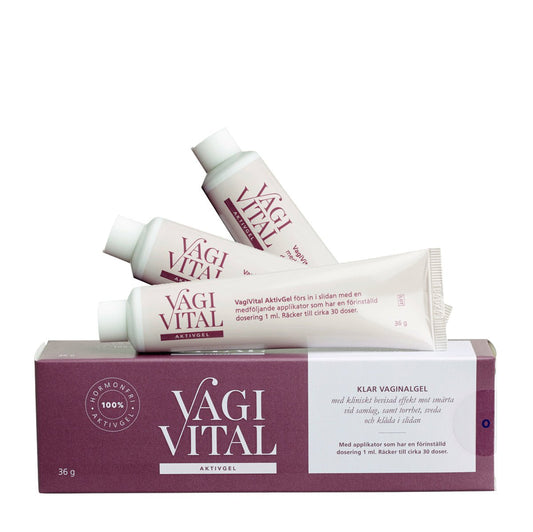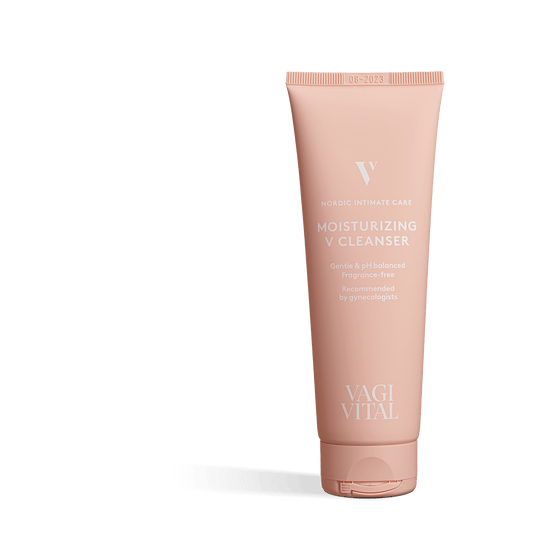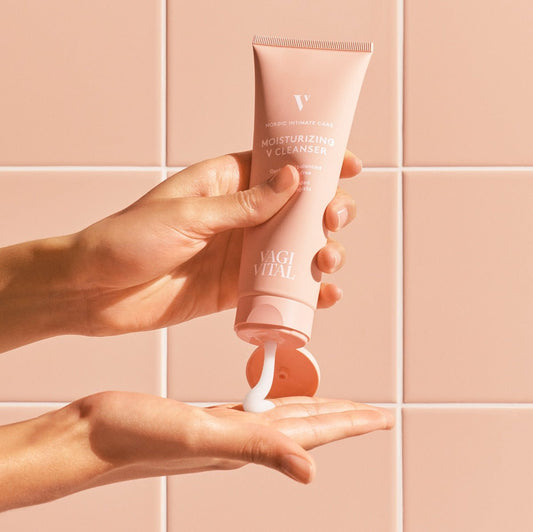Dry mucous membranes and atrophy in breast cancer
I am old enough to have undergone mammography several times, but I never get used to it. A few weeks ago, it was time again. After wandering around Karolinska University Hospital, I finally find the right place and check in at the reception, make my way through a corridor and up some stairs. I put on a pair of blue shoe covers and enter the waiting room where about 20 women are sitting and waiting. It is hard to miss that I am the only one who has decided to wear shoe covers. For a moment, I consider taking them off, but quickly realize that would be just as strange as wearing them, so I keep them on. Almost immediately, my name is called and I quickly stand up and shuffle out of the waiting room with the shoe covers rustling around my feet. A young and smiling nurse welcomes me into the room. She doesn’t even have time to explain what I should do next before I have taken a few quick steps to the small chair in the corner and started undressing my upper body. Then I stand there with bare breasts and those humiliating ugly shoe covers on my feet. Slowly, I turn around and start walking towards the gigantic “copier” that will X-ray my breasts. Because that is the only way I can explain a mammography machine. There is absolutely nothing that indicates this contraption is meant to X-ray soft, round breasts of various sizes and shapes. At first glance, it actually looks like some kind of copying machine, where the breasts are to be squeezed between the two square glass plates and then pressed together to get a clear image. Suddenly, I feel a bit unsure. How did you do this again? But the nurse explains with great experience and clarity: “Okay, and then you stand with your riiight side against the machine and then you put up your riiight breast.” I try to place my right boob correctly and the nurse also helps to tuck in the whole breast and then she tightens. Very tight! It’s not something that hurts terribly, but I can’t help thinking it’s completely absurd that in 2023 we still haven’t managed to develop a mammography device that is actually designed for breasts. There is also a mixed feeling about being here; partly it becomes somewhat comical in the whole situation where I stand half-naked, trapped with one breast in a “copying machine” with those ridiculous bags on my feet, partly there is a seriousness in the room. Because this is important and sometimes life-saving. Mammography ❤
DRY MUCUS MEMBRANES COMMON SIDE EFFECT OF BREAST CANCER TREATMENT
For women undergoing breast cancer treatment, vulvovaginal atrophy (VVA), which means dry, thin, and irritated mucous membranes in the vagina and vulva, can be both a painful and disturbing side effect. VVA resembles the condition that can occur after menopause, when the body produces less estrogen. Symptoms include vaginal dryness, itching, pain during urination, and pain during intercourse.
CAUSE OF DRY MUCUS MEMBRANES IN BREAST CANCER TREATMENT
Hormone-reducing therapy (HRT), used in the treatment of hormone-sensitive breast cancer, aims to lower the levels of sex hormones, especially estrogen, in the body. This is usually achieved by blocking estrogen receptors or reducing the body’s production of estrogen. Hormone therapy is used to prevent estrogen from stimulating the growth of cancer cells, as many types of breast cancer depend on estrogen for their growth. When estrogen decreases in the body, it also affects the mucous membranes in various parts of the body, including the vagina. This is one of the main causes of dry mucous membranes and mucosal atrophy during breast cancer treatment. Reduced estrogen production leads to the following changes in the mucous membranes:
🌺Thinner mucous membranes
Estrogen is important for maintaining the thickness of vaginal mucous membranes. When estrogen levels decrease, the mucous membranes become thinner.
🌺Reduced moisture
Estrogen contributes to the production of natural lubricants in the vagina. When estrogen decreases, moisture in the mucous membranes also decreases.
🌺Reduced elasticity
The mucous membranes lose their elasticity when estrogen decreases, which can cause discomfort and pain during intercourse.
🌺Increased vulnerability to infections
Thinner and drier mucous membranes are more susceptible to infections because they no longer have the protective barrier that would normally be present.
STUDY SHOWS THAT VAGIVITAL AKTIVGEL HELPS BREAST CANCER PATIENTS
A study has looked at whether VagiVital AktivGel can help women with breast cancer who have dry mucous membranes due to their treatment with aromatase inhibitors. Aromatase inhibitors are drugs used to treat breast cancer. They prevent the body from producing estrogen, a hormone that can cause cancer cells to grow. By using aromatase inhibitors, the amount of estrogen in the body can be reduced, thereby stopping the growth of cancer cells.
🌺 What the study did
The study included 28 women with breast cancer who had dry mucous membranes and were treated with aromatase inhibitors. They used VagiVital AktivGel every day for 12 weeks. At the start of the study, participants assessed how troublesome their symptoms were on a four-point (1–4) scale. Symptoms included irritation and itching in the genital area, vaginal dryness, pain during urination, and pain during intercourse.
🌺 Results
After 12 weeks with VagiVital AktivGel, the women noticed significant relief of their symptoms. The most impactful symptom decreased from an average of 2.71 to 1.33. Additionally, the total symptoms decreased from 5.39 to 2.25.
🌺 Conclusion
The results of the study suggest that VagiVital AktivGel is a very good treatment for women with breast cancer who suffer from dry mucous membranes due to aromatase inhibitor therapy. The treatment proved to be safe and improved the quality of life for the women. This is important because many breast cancer patients cannot use estrogen-based treatments due to risks. So VagiVital AktivGel can be a hopeful alternative for women struggling with dry mucous membranes during their breast cancer treatment.
Read the full study on VagiVital AktivGel here!
VAGIVITAL AKTIVGEL FOR DRY MUCUS MEMBRANES
VagiVital is a non-sticky, Swedish hormone-free vaginal gel that relieves and cures symptoms in the intimate area such as dryness, irritation or itching in the intimate area, discomfort during intimate contact, or pain during urination. The crystal-clear gel adheres to the vaginal mucosa and releases water to the mucosa over time, restores pH, and stimulates the growth of cells in the mucosal surface layer. Recommended by gynecologists and the results are clinically proven where the outcome has been documented in a multicenter study conducted together with female researchers (associate professors and professors in the field of gynecology) from Karolinska University Hospital, Uppsala University Hospital, and Norrland University Hospital.
You can find VagiVital AktivGel here!
RECOVERY OF DRY MUCUS MEMBRANES AFTER BREAST CANCER TREATMENT
The recovery of mucous membranes after breast cancer treatment can vary for each individual. Some women notice that their mucous membranes gradually return to normal when they finish hormone therapy or when their body resumes normal hormone production after treatment. Others may need continued treatment or relief to manage the discomfort of dry mucous membranes.
The time it takes for the vaginal mucous membranes to become dry during hormone-reducing therapy (HRT) also varies greatly between individuals. Not all women undergoing HRT experience immediate or any dryness of the mucous membranes. For some, changes in the mucous membranes occur quickly, while it may take longer for others.
In some women, dry mucous membranes can develop already within the first months of HRT treatment. At the same time, other women may not experience any symptoms at all for a long time or ever. Factors influencing this include the specific HRT treatment used, individual sensitivity to hormones, and previous health conditions.
Read Annika Cripps’ hopeful story about her breast cancer here!
IMPORTANT TO GO FOR MAMMOGRAPHY
Mammography is a simple and effective method to detect changes in breast tissue, including early signs of breast cancer that are impossible to feel by hand. By using X-rays, mammography can detect small changes long before they become noticeable. This is crucial because early detection significantly increases the chance of successful breast cancer treatment.
In Sweden, guidelines for mammography and how often it is recommended vary depending on age and risk factors. Generally, women between 40 and 74 years are offered regular mammography screenings within the framework of the Swedish national breast cancer screening program. It is common for women between 40 and 49 to be offered mammography every other year, while women between 50 and 74 are usually offered screening every year.
However, it is important to note that guidelines may vary slightly depending on the region and individual medical history. Some women with a higher risk of breast cancer may need more frequent mammograms. The Swedish cancer screening program aims to detect breast cancer at an early stage when treatment options are better, and mammograms play an important role in this preventive work.
I myself had almost forgotten my experience with the “copying machine” (because it really wasn’t that scary) when I picked up the mail this week and immediately saw on the envelope that it was the result of the mammography scan. I quickly opened the letter and read the sentence twice: "No signs of breast cancer were found in the Mammography scan." Phew! My heart skipped a little with relief. That little pulse increase was a reminder that mammography is not just an annoying procedure, it is also a kind of assurance of health and safety.
Take care of yourself, go to your mammography & Stay Pussytive ❤
/Fanny
Recommended products for you
- Choosing a selection results in a full page refresh.
- Opens in a new window.













